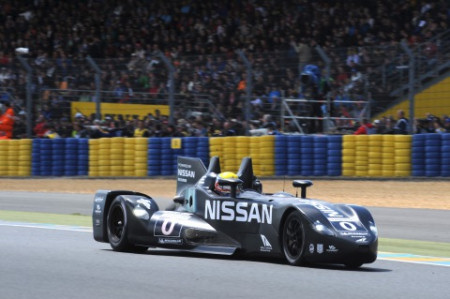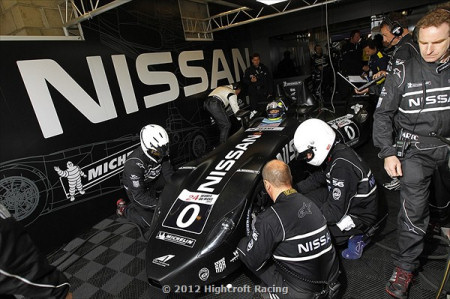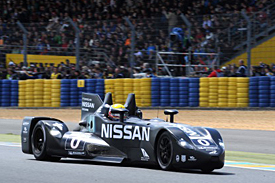Equally unfortunate was the early end to the Delta Wing's promising debut. The Nissan-powered prototype Delta Wing qualified comfortably in the middle of the field and ran well in the race until it was pushed off the track and into the crash barriers by the remaining Toyota. Satoshi Motoyama tried to repair the car and get it back to the pits but the Delta Wing was too badly damaged to continue.
"I had such a great time driving this car and I've loved working with Marino (Franchitti), Michael (Krumm) and the entire team," Motoyama said. "We have really shown what the future of sportscar racing could look like–ultra efficient. I really hope I can get the opportunity to drive the car again because we really do have unfinished business. I am certain the car would have run for a long time if not for the contact."
Added Krumm: "It's a sad way to finish the race because the car was really running strong. I had a couple of issues at the start of my time in the car, but my last two stints were really strong and felt great."
Delta Wing designer and motivator Ben Bowlby was disappointed with the result but delighted with the car's performance and the huge interest in the project from other competitors, fans and the media.
"First of all, the concept is proven," Bowlby remarked. "At the end of the day, the little Nissan Delta Wing weighing only 500 kilos, powered by the 300 horsepower Nissan DIG-T engine and using Michelin tires was able to run basically with half the fuel and tire consumption and yet show all of the speed of a typical Le Mans prototype.
"We showed an extraordinary and unbelievable concept on the track at Le Mans and the ACO provided us with a perfect setting to showcase the car's capabilities. Hats off to them for inviting us. It has been an incredible opportunity to showcase a car that is truly an innovative experiment.
© LAT USA "In the future let's hope we can bring it back as a race car, and not just an experimental vehicle. We'd love to see a future for cars of this type which are all about high efficiency, low drag and low consumption."
Marino Franchitti has led the Delta Wing's on track development program and is expected to race the car in some ALMS races this summer. Unfortunately because of its accident in the opening hours Franchitti was unable to drive the car in the race but he took considerable confidence from the car's performance in practice and qualifying.
"I was really happy with how the Nissan Delta Wing handled and felt in traffic," Marino commented. "The aero performance seemed consistent no matter what cars we ran with and that is a very important thing in multi class racing. The performance of the Michelin tires was just as we hoped and whether we have rain or shine, I'm confident in the grip we have from the rubber on the road.
"From the moment the car was unloaded off the truck we had a huge amount of interest around our garage. When the pit lane was open for fans everyone seemed to want to come and take a look and a lot of other drivers, team members and mechanics were also very interested too. It's nice that the car has had such a great reception from not only the fans, but also from our fellow competitors."
Nor must we forget that the Delta Wing makes its downforce exclusively through its underwing and aerodynamic shape without any external wings. Like spec cars, wings have come to be considered a plague on the sport and everyone has talked vaguely for years about inventing a way to eliminate wings but until the Delta Wing's arrival nobody had seriously tackled the question.
But Bowlby has done it and he was delighted to incorporate some of the thinking that went into the 1981 Eagle-Chevy and its unique 'Boundary Layer Adhesion Technology'. The shape of the Delta Wing's underwing is very similar to the '81 Eagle and it's doubly fascinating that the key controlling element for the Delta Wing's aero load and balance is a Gurney Flap invented forty years ago by Dan Gurney! It's also worth noting that the BLAT Eagle was banned by CART in 1983, surely one of the greatest technical blunders in the recent history of Indy car racing.
Another important element in Bowlby's original Delta Wing concept was utilizing an 'open-source' system to control the development and policing of the car. Bowlby created the Delta Wing not as a spec car but as a car to be built and developed by competing constructors using an open-source system. Two years ago Delta Wing founder Chip Ganassi emphasized one of the longterm goals of the concept.
"We're bringing an open-source way of doing business to the program where multiple manufacturers can be involved," Ganassi said. "Nobody wants a one-make or one-engine series. We want to see competition among car and engine builders so you'll have lots of iterations of the car along the way.
"We hope with the open-source concept we will attract students from all the engineering schools around the world and spark new thought and designs and have a continuing evolution of the revolution. We think what Linux has done can be done in racing."
Bowlby expanded on plans for the Delta Wing's 'open-source' system.

"We're absolutely dead-set against a one-make formula," Bowlby declared. "As we've learned, the equation of cost versus the marketability or sellability of a one-make formula doesn't work. We think there's also a value question in a completely free formula like Formula One. So what's the middle ground?
"The concept that we have come up with over a long period of time with a lot of detailed study is what we are describing as an open-source, open-access development protocol. Delta Wing is not a racing car constructor and that's not our ambition so the fact that we've designed a car means that we're not concerned about the intellectual property within the car. This car has been done for the good of the future of the racing."
Bowlby would like to see every detail and drawing of the Delta Wing available on-line.
"We're going to publish the entire production design," Bowlby related, "including the computer models of the components, the engineering drawings for the manufacture of those components, plus the parts list, the price structure and suppliers--you name it. The opportunity for teams and suppliers to download those things and either quote against manufacturing those parts, or in the case of a team they might chose to manufacture the parts themselves. Our original plan was for all this to be out there and available.
"Having the complete design effectively on a plate means you can also modify the design and submit your design for approval. In the big picture, as long as the design is published it's a part that's fit for racing. So it will allow teams to do what they want to do as long as it's within certain parameters of the regulations. But it's no longer a covert operation. We will share information. We've moved into an information/entertainment phenomenom. It's not a secret. Anybody can get access to the design. They can download it, modify it, submit it, or manufacture it."
Bowlby's concept would require a forward-thinking sanctioning body with the ability to act as the quality control house for all the parts and components.

"There's a lot of detail protocol that we've come up with to make the business model work," Bowlby added. "For example, every part that goes to a race will have to be inspected for quality assurance and conformity. There would be a charge levied for the parts. It won't be a big charge. It'll be enough to sustain the business and that will mean every part will have a unique part number and identifying tag which will allow the tech process to be a very clear and complete black and white process. As long as the parts conform to a published drawing, the car is legal."
It will be intriguing to see of the sport is capable of embracing Bolwby's open-source model. And it will be equally fascinating to see if an open-source system can control the rate of evolution and help reduce development costs.
Clearly the ALMS is the only American racing series capable of adopting the entire Delta Wing concept. Both Don Panoz and Scott Atherton have made it clear in this space and elsewhere that they want the Nissan Delta Wing to compete in as many ALMS races as possible this year. We look forward to hearing confirmation of such a plan as soon as possible.
by Gordon Kirby


 "We're absolutely dead-set against a one-make formula," Bowlby declared. "As we've learned, the equation of cost versus the marketability or sellability of a one-make formula doesn't work. We think there's also a value question in a completely free formula like Formula One. So what's the middle ground?
"We're absolutely dead-set against a one-make formula," Bowlby declared. "As we've learned, the equation of cost versus the marketability or sellability of a one-make formula doesn't work. We think there's also a value question in a completely free formula like Formula One. So what's the middle ground?  "There's a lot of detail protocol that we've come up with to make the business model work," Bowlby added. "For example, every part that goes to a race will have to be inspected for quality assurance and conformity. There would be a charge levied for the parts. It won't be a big charge. It'll be enough to sustain the business and that will mean every part will have a unique part number and identifying tag which will allow the tech process to be a very clear and complete black and white process. As long as the parts conform to a published drawing, the car is legal."
"There's a lot of detail protocol that we've come up with to make the business model work," Bowlby added. "For example, every part that goes to a race will have to be inspected for quality assurance and conformity. There would be a charge levied for the parts. It won't be a big charge. It'll be enough to sustain the business and that will mean every part will have a unique part number and identifying tag which will allow the tech process to be a very clear and complete black and white process. As long as the parts conform to a published drawing, the car is legal." 
